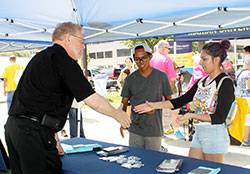Catholics offer ‘dialogue’ and ‘connecting point’ during Festival of Faiths in Indianapolis

Father Rick Ginther, left, director of the archdiocesan Office of Ecumenism and pastor of St. Patrick and St. Margaret Mary parishes, both in Terre Haute, greets visitors to his table representing the archdiocesan Office of Ecumenism at the Festival of Faiths in Indianapolis on Aug. 30. (Photo by Natalie Hoefer)
By Natalie Hoefer
As the St. Rita Parish Gospel Choir lifted their voices in song, the crowd lifted their hands clapping in appreciation. They were hands of not just Catholics, but also Buddhists, Sikhs, Jews, Muslims and more.
The religious mix took place outdoors at the Festival of Faiths at Veterans Memorial Plaza in downtown Indianapolis on Aug. 30. It was the third year for the event, sponsored by the Center for Interfaith Cooperation (CIC), a multi-religion member organization that promotes peace through understanding and cooperation among those of different faith traditions.
“The organization is really there to provide an opportunity for people to have a greater understanding of one another,” explained Glenn Tebbe, executive director of the Indiana Catholic Conference and a member of St. Mary Parish in Greensburg. “You do that a lot of times through joint effort.
“So the CIC allows for the opportunity to come together and do that. This festival is just an expression of that [coming together].”
Interaction was encouraged at the four-hour festival, which included 80 tents representing different religions, churches, organizations and societies, as well as food, merchandise vendors and a performance stage.
The Archdiocese of Indianapolis offered information and interaction at three of those tents.
“The archdiocese always needs to be in the midst of [interreligious efforts],” said Father Rick Ginther, director of the archdiocesan Office of Ecumenism and pastor of St. Patrick and St. Margaret Mary parishes, both in Terre Haute. “It was ‘Nostra Aetate’ [the Second Vatican Council’s “Declaration on the Relation of the Church with Non-Christian Religions”] that broke this open for the world religions to be able to start to talk to each other.”
The goal of the archdiocesan presence at the festival, said Father Ginther, was “to show three different aspects of Catholicism: our charitable outreach, how we reach out to other religions, and how we worship.”
At that moment in the interview, passersby stopped by the tent of the Office of Ecumenism. Father Ginther greeted them warmly, chatted with them, gave them some material and shook their hands before they left.
“Most people who stop by are curious,” he explained afterward. “Many of them are shy and don’t know what to ask. I start by asking them what their religious background is, if they have a faith. That [helps] them to interact.”
At the ecumenism tent, rosary rings were available for the taking. Andrew Motyka, who was working at the archdiocesan tent next to Father Ginther’s, said the rosary rings were popular.
“The most interesting things we’ve been answering are questions about the rosary rings,” said Motyka, archdiocesan director of liturgical music and cathedral music. “People had never seen those. The rosary seems to be something people connect to whether they’re Catholic or not. It has its own cultural identity, so to have these rings to give out and say, ‘Hey, here’s another way to pray,’ has been a nice connection point with people.”
In the archdiocesan Office of Worship tent where Motyka stood, several sacramentals and items used during Mass adorned the table, including a crucifix, unconsecrated hosts and wine, candles, oil and other items.
“People have a lot of questions about the sacraments because frequently the only time they come to a Catholic church is for a baptism or a wedding,” he said. “So they might not realize exactly what’s going on, and there’s not time at that point to teach about it. I’m glad to be able to answer some questions and have a connecting point to be able to talk to people.”
Deacon Ronald Pirau found himself also clarifying misconceptions at the Catholic Charities tent.
“There were some folks here talking about some ministries at a [Catholic] church in their neighborhood, like a soup kitchen,” he recalled. “They thought that was what Catholic Charities did. I find a lot of people think that the face of Catholic Charities is all the things going on in the parish. But it’s good that people recognize good works.”
A running theme in this year’s Festival of Faiths was how various religions celebrate weddings. Demonstrations of Jewish, pagan and Sikh ceremonies were held during the afternoon.
“When you boil it down, our weddings are pretty simple,” said Father Ginther of Catholic wedding ceremonies. “It’s two rings, a vow formula, two witnesses and a priest. It’s much simpler than going to a Jewish wedding where there’s the breaking of the glass.
“Other cultures that are Catholic, you see a lot of things added like the lasso and coins with the Filipinos and Hispanics [ceremonies], but the Anglos are pretty sober,” he added with a smile.
The existence of weddings and marriage are one of many commonalities among people of different religions.
“We’re all parents and grandparents,” said Maria Pimentel-Gannon, a CIC board member and member of St. Monica Parish in Indianapolis. “We all have parents and children. We all want the same things—peace, food on our table, employment and to be a contributing member of society.
“Even though some may be at different ends of the [religious] spectrum, there [must be] respect and a willingness to try to understand, talk and dialogue. Dialogue is the way to peace.”
(For more information on the Center for Interfaith Cooperation, log on to www.centerforinterfaithcooperation.org.) †
